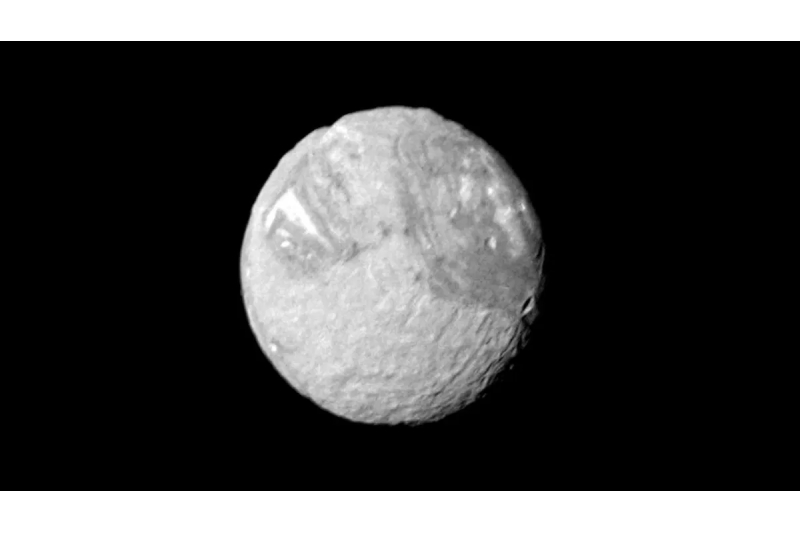Scientists have proposed that a hidden ocean of water on an unwary moon that lurks in our solar system may potentially be home to extraterrestrial life.
The small world A study published in The Planetary Science Journal suggests that Miranda, one of the moons of the ice giant Uranus, may have an ocean of liquid water beneath its surface.
Because of this, Miranda is one of the few planets in our solar system where life could be able to flourish in its deep water.
In a statement, study co-author Tom Nordheim, a planetary scientist at Johns Hopkins University’s Applied Physics Laboratory, stated, “To find evidence of an ocean inside a small object like Miranda is incredibly surprising.”
“It helps build on the story that some of these moons at Uranus may be really interesting—that there may be several ocean worlds around one of the most distant planets in our solar system, which is both exciting and bizarre,” he stated.
What Is Uranus’s Moon Count?
Of Uranus’s 28 known moons, 27 have been named, mostly after figures from Alexander Pope and William Shakespeare’s plays. At roughly 290 miles in diameter, Miranda is roughly one-seventh the size of our moon, making it the smallest of Uranus’ big moons, after Titania, Oberon, Umbriel, and Ariel. Like the majority of Uranus’ moons, it is thought to be primarily made of rock and water ice. Its surface is patchworked with various terrain types, such as massive canyons, ridges, and cliff walls. It is generally believed that interior heating brought on by gravitational interactions with Uranus is what created these features.
This new research challenges our preconceived notions about how Miranda evolved by revealing that beneath its stony and ice surface lies an ocean of liquid water.
In order to ascertain what the inside of the moon must be like, the researchers reverse-engineered Miranda’s peculiar geology based on gravitational interactions with Uranus, as they explain in the publication.
They found that the moon having a huge subterranean ocean between 100 million and 500 million years ago was the most likely scenario to cause Miranda’s peculiar look. This ocean, which is roughly 60 miles deep behind a 20-mile-thick layer of ice, would have occupied more than half of the moon’s surface.
“That result was a big surprise to the team,” said Caleb Strom, a University of North Dakota graduate student who co-authored the paper.
The tidal forces between Miranda and the other moons of Uranus, which can be exacerbated if the moons orbit a planet at specific rates, are probably what generated this ocean. A moon’s interior is heated by these gravitational pulls, turning ice into liquid water. It is believed that this mechanism explains why Europa, Jupiter’s moon, also possesses a subterranean ocean.
“That result was a big surprise to the team,” said Caleb Strom, a University of North Dakota graduate student who co-authored the paper.
The tidal forces between Miranda and the other moons of Uranus, which can be exacerbated if the moons orbit a planet at specific rates, are probably what generated this ocean. A moon’s interior is heated by these gravitational pulls, turning ice into liquid water. It is believed that this mechanism explains why Europa, Jupiter’s moon, also possesses a subterranean ocean.
The ocean has probably frozen considerably after the genesis of the moon’s peculiar surface structures since Uranus’ moons have since desynchronized from the orbital resonances that would have produced the ocean. The experts speculate that some liquid water may still be present beneath the ocean’s surface, suggesting that it has not yet completely frozen.
“The suggestion of an ocean inside one of the most distant moons in the solar system is remarkable,” Strom stated.
The discovery of a subterranean ocean on Saturn’s Enceladus, another moon in the solar system, in 2004 has made the moon a strong contender for extraterrestrial life.
In the release, co-author Alex Patthoff, a researcher at the Planetary Science Institute in Arizona, said, “Few scientists expected Enceladus to be geologically active,” “However, it’s shooting water vapor and ice out of its southern hemisphere as we speak.”
Therefore, the hunt for extraterrestrial life may eventually target Miranda as well. To determine if the ocean is still liquid or if it ever existed at all, however, a great deal more investigation is required.
“We won’t know for sure that it even has an ocean until we go back and collect more data,” Nordheim stated. “We’re squeezing the last bit of science we can from Voyager 2’s images. For now, we’re excited by the possibilities and eager to return to study Uranus and its potential ocean moons in depth.”
